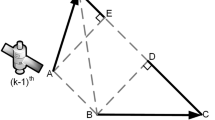Abstract
Recent years have witnessed the emergence of portable global navigation satellite spoofing devices. A variety of anti-spoofing techniques have been dedicated to detecting the presence of spoofing signals, most of which solely utilize either signal characteristics or navigational information. However, since the GNSS system is under continuous monitoring and control, there is a subtle consistency between the signal and the navigational information in authentic GNSS signals, which the spoofing signal can hardly counterfeit. Here, we present a new dual-antenna spoofing detection technique based on this consistency. The essence of this method is the precise estimations of the frequency difference of arrival between a pair of fixed antennas from both the carrier phase observations and the navigational information. When there is no spoofing signal, the observation should be consistent with the prediction. Otherwise, spoofing signals would probably break the consistency because of the geometric and motion discrepancies between GNSS satellites and the spoofing device(s). Theoretically, since the proposed method does not make any presumptions about the spoofer, it can detect moving spoofers and multi-antenna spoofers. We analyze the optimal detection method in three different situations, and the corresponding detection performances are both theoretically and numerically investigated. We also intensively conduct experiments with various configurations to prove the detection capabilities against various spoofing techniques and strategies.











Similar content being viewed by others
References
Amin MG, Sun W (2005) A novel interference suppression scheme for global navigation satellite systems using antenna array. IEEE J Sel Areas Commun 23(5):999–1012
Bhatti J, Humphreys TE (2017) Hostile control of ships via false GPS signals: demonstration and detection. Navigation 64(1):51–66
Borio D, Gioia C (2016) A sum-of-squares approach to GNSS spoofing detection. IEEE Trans Aerosp Electron Syst 52(4):1756–1768
Gross J, Humphreys TE (2017) GNSS spoofing, jamming, and multipath interference classification using a maximum-likelihood multi-tap multipath estimator. In: Proceedings of the ION ITM 2017. Institute of Navigation, Monterey, January 30-2, pp 662–670
Humphreys TE, Ledvina BM, Psiaki ML, O’Hanlon BW, Kintner Jr PM (2008) Assessing the spoofing threat: development of a portable GPS civilian spoofer. In: Proceedings of the ION GNSS 2008. Institute of Navigation, Savannah, September 16–19, pp 2314–2325
Jafarnia A, Broumandan A, Daneshmand S, Sokhandan N, Lachapelle G (2014) A double antenna approach toward detection, classification and mitigation of GNSS structural interference. In: Proceedings of NAVITEC 2014, ESA-ESTEC, Noordwijk, December 3–5
Jafarnia-Jahromi A, Broumandan A, Nielsen J, Lachapelle G (2012) GPS vulnerability to spoofing threats and a review of antispoofing techniques. Int J Navig Observ vol 2012, Article ID 127072
Kaplan E, Hegarty C (2005) Understanding GPS: principles and applications, 3rd edn. Artech House, Norwood, p 474
Magiera J, Katulski R (2015) Detection and mitigation of GPS spoofing based on antenna array processing. J Appl Res Technol 13(1):45–57
Montgomery PY (2011) Receiver-autonomous spoofing detection: experimental results of a multi-antenna receiver defense against a portable civil GPS spoofer. In: Proceedings of the ION ITM 2009. Institute of Navigation, Anaheim, January 26–28, pp 124–130
Psiaki ML, Humphreys TE (2016) GNSS spoofing and detection. Proc IEEE 104(6):1258–1270
Psiaki ML, O’hanlon BW, Bhatti JA, Shepard DP, Humphreys TE (2011) Civilian GPS spoofing detection based on dual-receiver correlation of military signals. In: Proceedings of the ION GNSS 2011. Institute of Navigation, Portland, September 20–23, pp 2619–2645
Psiaki ML, O’hanlon BW, Powell SP, Bhatti JA, Wesson KD, Humphreys TE (2014) GNSS spoofing detection using two-antenna differential carrier phase. In: Proceedings of the ION GNSS + 2014. Institute of Navigation, Tampa, September 8–12, pp 2776–2800
Seo S-H, Lee B-H, Im S-H, Jee G-I, Kim K-S (2018) Efficient spoofing identification using baseline vector information of multiple receivers. GPS Solut 22(4):115
Shepard DP, Bhatti JA, Humphreys TE, Fansler AA (2012) Evaluation of smart grid and civilian UAV vulnerability to GPS spoofing attacks. In: Proceedings of the ION GNSS. Institute of Navigation, Nashville, September 17–21, pp 3591–3605
Tanıl Ç, Khanafseh S, Joerger M, Pervan B (2018) An INS monitor to detect GNSS spoofers capable of tracking vehicle position. IEEE Trans Aerosp Electron Syst 54(1):131–143
Tippenhauer NO, Pöpper C, Rasmussen KB, Capkun S (2011) On the requirements for successful GPS spoofing attacks. In: Proceedings of the 18th ACM conference on computer and communications security. ACM, Chicago, October 17–21, pp 75–86
Vagle N, Broumandan A, Lachapelle G (2018) Multi-antenna GNSS and inertial sensors/odometer coupling for robust vehicular navigation. IEEE Internet Things J 5(6):4816–4828
Van Diggelen F, Brown (1994) A mathematical aspects of GPS RAIM. In: Position location and navigation symposium. IEEE, Las Vegas, April 11–15, pp 733–738
Wesson K, Rothlisberger M, Humphreys T (2012) Practical cryptographic civil GPS signal authentication. Navigation 59(3):177–193
Zhang Z, Gong S, Dimitrovski AD, Li H (2013) Time synchronization attack in smart grid: impact and analysis. IEEE Trans Smart Grid 4(1):87–98
Acknowledgment
This work was supported by the National Natural Science Foundation of China (Grant No. 61571255) and Tsinghua University Initiative Scientific Research Program (Grant No. 2018Z05JZY004).
Author information
Authors and Affiliations
Corresponding author
Additional information
Publisher's Note
Springer Nature remains neutral with regard to jurisdictional claims in published maps and institutional affiliations.
Rights and permissions
About this article
Cite this article
He, L., Li, H. & Lu, M. Dual-antenna GNSS spoofing detection method based on Doppler frequency difference of arrival. GPS Solut 23, 78 (2019). https://doi.org/10.1007/s10291-019-0868-5
Received:
Accepted:
Published:
DOI: https://doi.org/10.1007/s10291-019-0868-5




